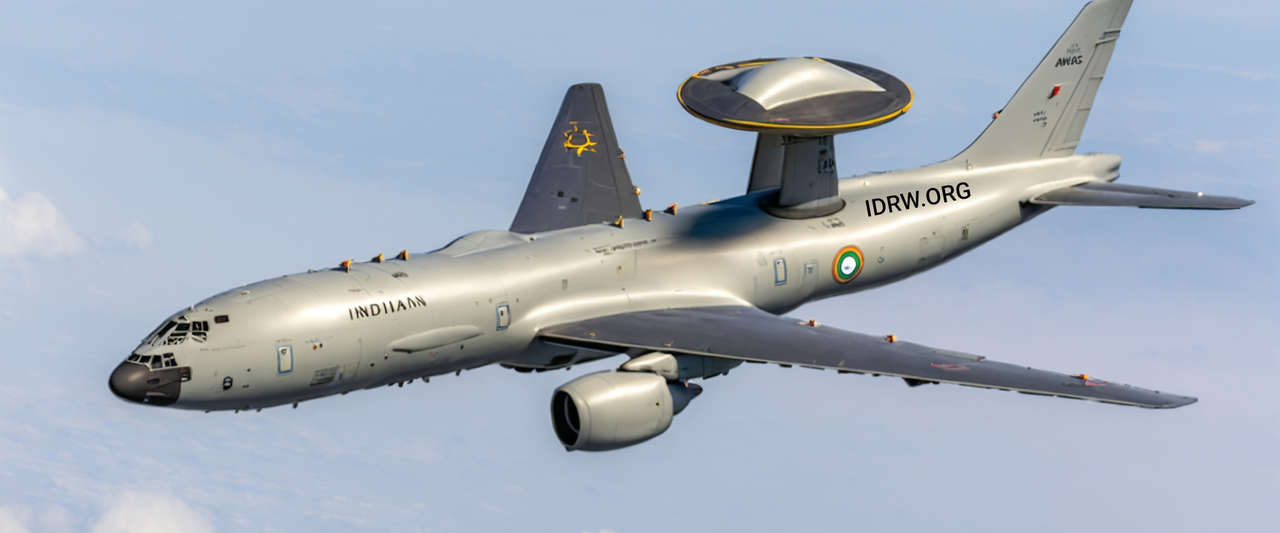SOURCE: RAUNAK KUNDE / NEWS BEAT / IDRW.ORG


The Ministry of Defence (MoD), Government of India, has issued a Request for Information (RFI) aimed at the procurement of six (06) Airborne Early Warning and Control (AEW&C) systems, along with the necessary ground segment infrastructure. This RFI invites proposals from registered Indian vendors for the supply of these advanced systems. The AEW&C system is a crucial part of the Indian Air Force’s (IAF) modernization efforts, aimed at enhancing air defense and surveillance capabilities.
The AEW&C systems are a sophisticated “system of systems” designed to provide long-range radar detection and comprehensive situational awareness. The primary functions include Long-range radar detection, Electronic Surveillance Measures (ESM), Communication Support Measures (CSM), Command & Control (C2), Battle management, and Data link-based networking for real-time integration.
The AEW&C system includes a modified aircraft capable of housing the required onboard sensors and systems. The expected features of the aircraft include a Multi-sensor platform integrated with the latest command and control systems. Endurance: Over 8 hours of continuous operational capability. Air-to-air refueling capability and fuel dumping capacity . Operational altitude: Above 40,000 feet. Capability to take off and land from airfields at elevations of up to 1,660 meters Above Mean Sea Level (AMSL) with a runway length suitable for operational efficiency
The AEW&C platform will incorporate a multimode, multifunctional solid-state Active Electronically Scanned Array (AESA) radar. Key radar capabilities include 360-degree coverage, Detection and tracking of large aircraft to low Radar Cross Section (RCS) targets such as UAVs and helicopters. Detection range of at least 400 km for targets with RCS of 5 m², Range of at least 550 km in Extended Range (LR/ER) Search Mode.
Range of 425 km for larger targets (RCS 500 m²), Ground Moving Target Indicator (GMTI), Hypersonic Mode, etc., Ability to detect airborne targets flying at altitudes ranging from 30 meters to 20 kilometers with Elevation coverage of 50 meters to 20 kilometers.
AEW&C system also should include Electronic Surveillance Measures (ESM) with 360-degree azimuth coverage, Infrared Missile Warning System (MAWS) with 360-degree coverage for detecting incoming missiles, Laser-based Aircraft Infrared Countermeasures (LAIRCM) integrated for automatic cueing, Countermeasure Dispensing System (CMDS) for effective chaff and flare dispensation.
The AEW&C system is expected to incorporate state-of-the-art technology for real-time data integration and fusion. The mission suite must include Automatic data fusion of sensors, including Radar, Identification Friend or Foe (IFF), ESM, and CSM, Capability to integrate data from friendly aircraft over data links such as Software Defined Radio (SDR), Ground Exploitation Station (GES) and Data Link systems must be fully compatible with the IAF’s existing operational data links, The system must support seamless integration with the IAF’s Command and Control (C2) network, enabling effective network-centric operations.
The procurement process, from the issuance of a Request for Proposal (RFP) to the signing of a contract, will follow the guidelines set forth in Appendix L to Chapter 2 of the Defence Acquisition Procedure (DAP) 2020. The anticipated delivery timeline for the six AEW&C systems and the associated ground segment is between 36 to 60 months after the contract is signed.
Vendors are required to provide a rough estimate of the cost for six AEW&C systems along with the associated ground segment. The cost must cover the fully modified aircraft, all onboard systems, and the necessary ground support equipment.
NOTE : Article cannot be reproduced without written permission of idrw.org in any form even for YouTube Videos to avoid Copy right strikes. Websites doing illegal reproductions will get DMCA and Legal Notices.